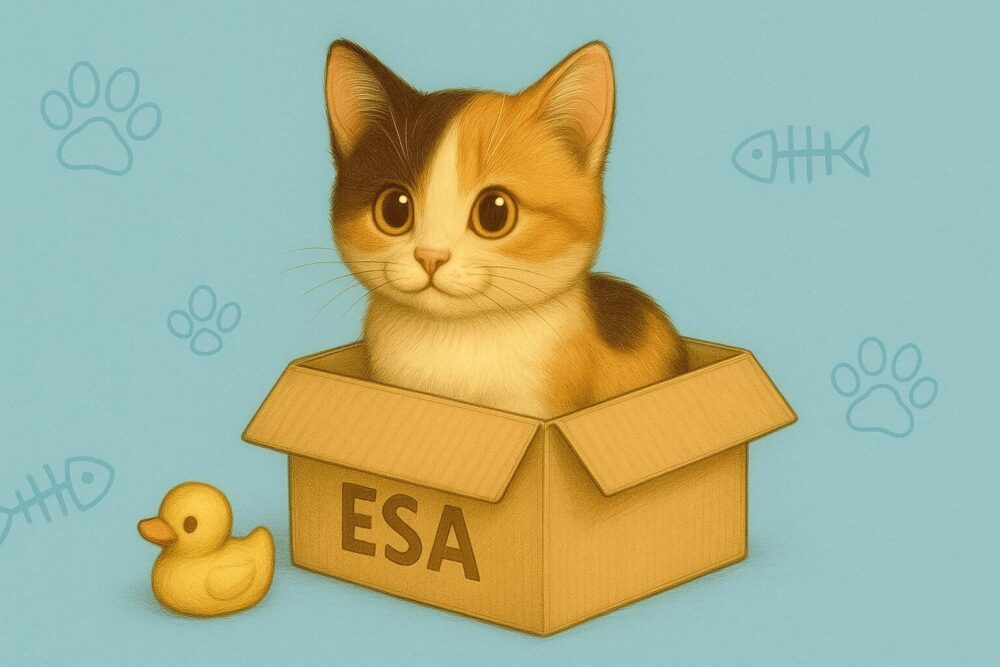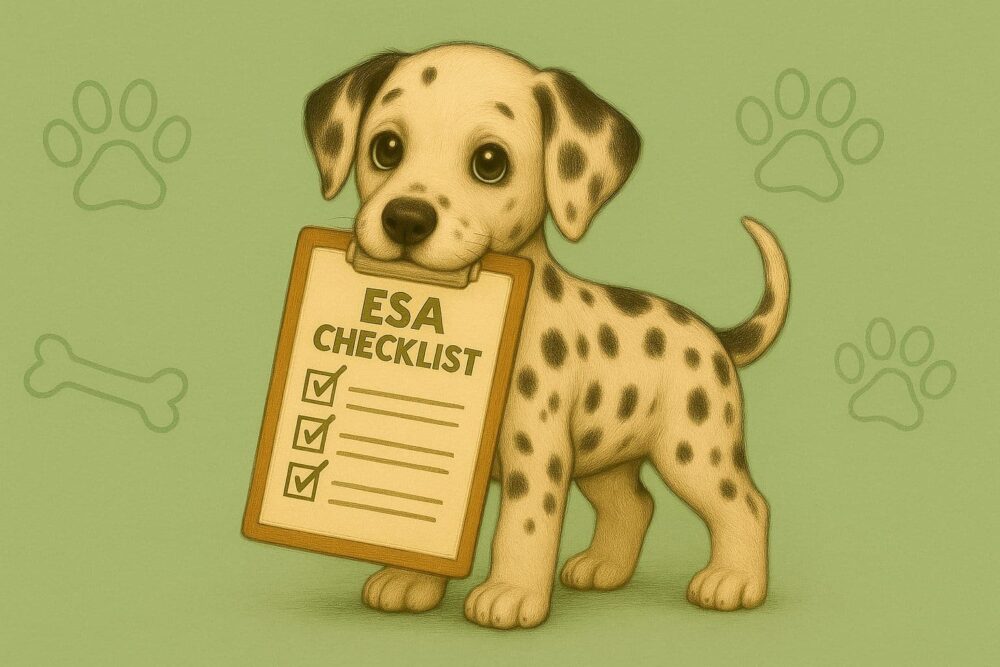
Table of Contents
For someone struggling with mental health challenges, living with an emotional support animal (ESA) can provide a calming presence, a reason to get out of bed, and a source of joy on tough days. Think of them as your personal cheerleader—only with fur and a wagging tail or soft whiskers.
If you’ve been considering adding this special kind of support to your life, you’re probably wondering exactly how to get an emotional support animal. Well, the process isn’t as complicated as you might think.
In this guide, we’ll walk you through every step of the journey—from determining if you qualify to getting the right documentation and welcoming your new furry companion home.
What’s Considered an Emotional Support Animal (ESA)?
If you’re struggling with anxiety, depression, PTSD, or other mental health problems, your ESA can be a source of comfort during difficult times. These animal buddies help reduce feelings of loneliness and provide therapeutic benefits just by being their adorable selves.
Not all pets can be considered ESAs—these animals are prescribed by a licensed mental health professional (LMHP) and are protected under the law, granting them special benefits over common pets.
The Fair Housing Act (FHA) is the main federal law that gives you the right to live with your ESA in most housing—even if the landlord has a “no-pets” policy or has certain breed or size restrictions.
ESAs vs. Service Animals—What’s the Difference?
There’s a lot of confusion between the terms “ESAs” and “service animals,” and you might’ve seen them used interchangeably. But the truth is—they have completely different purposes and legal protections. That’s why the process of getting one isn’t the same for both.
Service animals are specifically trained to assist people with disabilities. Think guide dogs for the visually impaired or seizure-alert dogs. These animals perform essential tasks, such as:
- Pulling a wheelchair
- Retrieving dropped items
- Providing stability for people with mobility issues

ESAs, on the other hand, don’t need specialized training. Their job is to provide comfort and emotional stability through their companionship alone. Here’s a breakdown of what differentiates these two:
| Aspect | Emotional Support Animals | Service Animals |
| Legal foundation | Fair Housing Act (FHA) | Americans with Disabilities Act (ADA) |
| Public access | Limited to housing (apartments, condos, dorms, etc.) | Protected access to most public places (restaurants, stores, schools, hotels, etc.) |
| Purpose | Provide comfort through presence and companionship | Perform specific functional tasks (guiding, alerting, etc.) |
| Documentation | Require an ESA letter from a licensed mental health professional | Only specialized training related to the owner’s disability is required |
| Qualifying species | Most domesticated animals | Mostly dogs and sometimes miniature horses |
How To Get an ESA—5 Essential Steps
Before you start picking out cute pet names or browsing adoption websites, there are a few steps to follow. Here’s the complete process showing how to get an ESA approved:
- Determine if you qualify for an ESA
- Choose the right type of animal to be your ESA
- Get evaluated by a licensed mental health professional (LMHP)
- Obtain an official ESA letter
- Submit the letter to your landlord or housing provider
Determine if You Qualify for an ESA
Not everyone who loves animals qualifies for an emotional support animal—though wouldn’t that be nice?
To be eligible for an ESA, you typically need to have a condition listed in the latest version of the Diagnostic and Statistical Manual of Mental Disorders (DSM-5-TR). Some commonly qualifying conditions include:
- Depression
- Anxiety disorders (including PTSD, social anxiety, and panic disorder)
- Phobias
- Attention deficit hyperactivity disorder (ADHD)
- Chronic stress
- Bipolar disorder
If you’ve been diagnosed with one of these and feel that an animal would help you cope, you may be eligible for an ESA. Even if you haven’t been formally diagnosed, that’s okay—many people discover their need for an ESA during conversations with a mental health professional.
Choose the Right Type of Animal To Be Your ESA
Almost any animal can qualify as an ESA as long as it provides you with comfort and emotional support, helping alleviate your specific symptoms. This means you’ve got options, but it’s important to choose your companion according to your needs, lifestyle, and living situation.
Here are some common choices:
| Animal | Reasons To Get It |
| Dogs | Loyal, loving, and great for active lifestyles |
| Cats | Independent yet affectionate, perfect for smaller spaces |
| Birds | Social and fluffy, ideal for those who want a feathered friend |
| Rabbits | Quiet, soft, and surprisingly affectionate |
| Small mammals (like guinea pigs or hamsters) | Low-maintenance and great for cuddling |
While undomesticated or potentially dangerous animals don’t make the cut (sorry, tarantula owners!), species isn’t the main consideration when getting an ESA. That’s why even some unconventional choices can qualify—like emotional support chickens.
Don’t fret if you’re not sure about the type of animal yet. Talk to your mental health professional, visit local shelters, or spend time with friends’ pets to get a sense of what feels right. Remember, there’s no such thing as a perfect ESA—there’s just the right one for you.
Get Evaluated by a Licensed Mental Health Professional (LMHP)
To make things official, you’ll need to get a professional evaluation done by an LMHP in your state. Both in-person and telehealth consultations are valid as long as an actual medical evaluation is involved. Your LMHP can be any one of these qualified professionals:
- Psychologist
- Psychiatrist
- Licensed clinical social worker (LCSW)
- Licensed professional counselor (LPC)
- Therapist or counselor with relevant credentials
The LMHP will discuss your mental health history, current symptoms, and the way they impact your daily functioning. Based on the consultation, the professional will determine if your condition qualifies and if an ESA would genuinely benefit you.

Obtain an Official ESA Letter
If approved, the professional will issue an official document confirming your legitimate need for an ESA. This formal documentation comes in the form of an ESA letter, which protects your rights under laws like the FHA.
To be considered valid under the FHA, the ESA letter you get from your LMHP must confirm that:
- You have a diagnosed mental or emotional disability recognized in the DSM-5
- Your disability substantially limits one or more major life activities
- An emotional support animal is necessary as part of your treatment plan
In addition to the above, the letter needs to come on your LMHP’s official letterhead, address you explicitly, and include the professional’s National Provider Identification Number, state license number, and contact information.
If you’re not already seeing a mental health professional, you can still get an ESA letter elsewhere. Many licensed professionals offer evaluations specifically for ESAs, and some even provide them online. Just make sure you’re working with a reputable provider—avoid sketchy websites that promise instant or dirt-cheap ESA letters without a real evaluation.
Your LMHP will typically provide the letter during or shortly after your evaluation. Still, the LMHP isn’t obligated to write an ESA letter, and they might refuse if they believe that an ESA might not be a good fit or if you don’t have a qualifying medical condition.
Submit the Letter to Your Landlord or Housing Provider
So, now you’ve got your official ESA letter in hand and are ready to move in with your cuddly companion into your new home. But then you hit a snag—your landlord has the personality of a grumpy cat and might raise eyebrows when you’re trying to make it official with them.
The good news? You need not worry!
The FHA recognizes that ESAs aren’t just pets—they’re assistance animals that help alleviate symptoms of disabilities. This means landlords and housing providers must make “reasonable accommodations” for tenants with ESAs, irrespective of their pet policies. They can’t deny you housing or charge you extra pet fees or deposits as long as you provide your ESA letter as proof that your animal is part of your treatment plan.

Still, if a landlord denies your legitimate ESA request, you can file a complaint with the U.S. Department of Housing and Urban Development (HUD), which enforces the FHA. ESA rules and protections are strict, and landlords may be subject to discrimination lawsuits and heavy fines if they violate these regulations (up to $16,000 for a first violation).
Why Getting a Support Animal Isn’t All Cuddles and Purrs—Key Challenges
While the benefits of having an ESA are absolutely worth the effort, the process of getting one isn’t always a walk in the park. Before you can comfortably spend unlimited time with your furry family member, prepare yourself for these potential hurdles:
- Going through a lengthy procedure to get an ESA letter
- Abiding by local and state laws
- Dealing with online ESA letter scams
- Facing skepticism from landlords
Going Through a Lengthy Procedure To Get an ESA Letter
Picture this—you’ve already named your future support animal and found the perfect apartment with a move-in date just two weeks away. But then, the process of getting your ESA letter feels like it’s moving at the speed of a snail on a lazy Sunday while your housing opportunity might slip away.
With the traditional route to obtaining an ESA letter, there’s the challenging period of finding an LMHP who understands ESA regulations and whose calendar isn’t booked weeks in advance. After all, many professionals aren’t familiar with the requirements for writing ESA letters or may be hesitant to provide them.
Then comes the waiting game. Even after finding the right professional, you might face:
- Initial consultation wait times (often 2–3 weeks for new patients)
- Follow-up appointments to establish the “therapeutic relationship” some states require
- Additional sessions to discuss your specific need for an ESA
- Administrative processing time for the actual letter
Abiding by Local and State Laws
In addition to federal laws like the FHA, each state can have its regulations regarding ESAs, adding another layer of complexity. For example, states like California and Iowa require you to have a 30-day established relationship with your LMHP before they can issue an ESA letter.
Similarly, local housing laws might have specific rules about the types of animals allowed or the number of animals per household. You’d need to research your state and local laws to understand any additional requirements for an emotional support animal and save yourself a lot of headaches.
Dealing With Online ESA Letter Scams
If you’re taking the online ESA letter route, you’ll quickly find that the internet is filled with websites that make the process of securing an ESA letter seem as easy as ordering a pizza.
The truth is that all those websites offering “instant ESA registration” or “free ESA letters” are most likely scams. These fraudulent services not only waste your money but can land you in serious trouble when your landlord inevitably discovers your documentation is fake.
Watch out for the following clues to identify these sneaky scammers:
- Instant ESA letters—If a website offers “instant downloads” upon paying a fee, it’s a red flag. Legitimate ESA letters require a thorough assessment by an LMHP, which takes time to set up and process
- Misleading legal claims—Some fake services may promise that their ESA letter gives your animal public access rights (similar to service animals). In reality, ESA letters only provide housing-related accommodations
- Too good to be true prices—Legitimate ESA evaluations typically cost between $150–$200 due to the time and expertise of the professional involved. If the price seems ridiculously low (e.g., less than $50), it’s probably a scam
Facing Skepticism From Landlords
The unfortunate surge in ESA scams isn’t just detrimental to tenants—it has made property owners and managers wary of ESA owners. With countless renters abusing fake ESA letters to circumvent “no pets” policies or avoid pet deposits, many landlords have become increasingly skeptical of all ESA requests—even legitimate ones.

Some landlords may also have real concerns about property damage, liability, and maintaining peaceful communities. Others may not fully understand the housing acts and their legal obligations.
If you’re facing pushback from your landlord, politely explain your rights under the FHA and let them know you have valid documentation for your ESA. In case your landlord refuses your request or gives you a hard time, you can always take the legal route.
Avoid Scams and Hassles With a Legit ESA Letter Provider
Now that you know an ESA letter is the only thing standing between you and living with your four-legged therapist worry-free, you need to choose the right service to avoid roadblocks due to invalid documentation. Here’s what makes an ESA letter provider legit:
- Actual evaluation involved—The provider should connect you with an LMHP through a video call so they can examine your specific condition and requirements and decide whether to prescribe an ESA
- Transparent process—Legit providers will clearly explain their process, fees, and turnaround times. They’ll provide clear pricing and renewal information with no hidden surprises
- No “registry” or “certification” offerings—There’s no official registry or government-approved certification for ESAs, so any service offering to register your ESA isn’t legitimate
- Money-back guarantee—A reputable provider will stand by their service with a satisfaction or money-back guarantee, something that suspiciously cheap ESA letter services often overlook
With so many options out there (and many illegitimate ones), it can be hard to know who to trust. Luckily, Your Service Animal offers a professional network of LMHPs and full compliance with legal and ethical standards, making the process of getting an ESA letter fast and hassle-free.
Why Choose Your Service Animal for Your ESA Letter
Your Service Animal is an online platform that provides a convenient way to receive a professional ESA letter from the comfort of your home—because living with your support animal should relieve your stress, not add to it.
The platform connects you with an LMHP registered and practicing in your state to ensure all letters meet federal and state requirements. Here are some more benefits you get with Your Service Animal:
| Benefit | Why It Matters |
| Quick and free qualification quiz | Take a no-obligation quiz to determine if you might qualify before spending a penny |
| Licensed professionals | Connect with vetted mental health professionals licensed specifically in your state |
| Convenient online process | Enjoy a fully remote and online process, from the initial quiz to the telehealth consultation and letter delivery |
| Fast (but not instant) turnaround | Receive your ESA letter within 24–48 hours after completing your consultation |
| Full money-back guarantee | Get a 100% refund if you don’t qualify or if your letter isn’t accepted |
Get Your Official ESA Letter With Ease
Ready to welcome your animal buddy home? Take these next steps now:
- Find out if you’re a good fit for an ESA letter with our online quiz
- Schedule an online appointment with a licensed mental health practitioner in your state
- Attend the online call and receive your ESA letter if clinically appropriate
- Receive a full refund if the therapist doesn’t issue an ESA letter or your landlord rejects your letter








